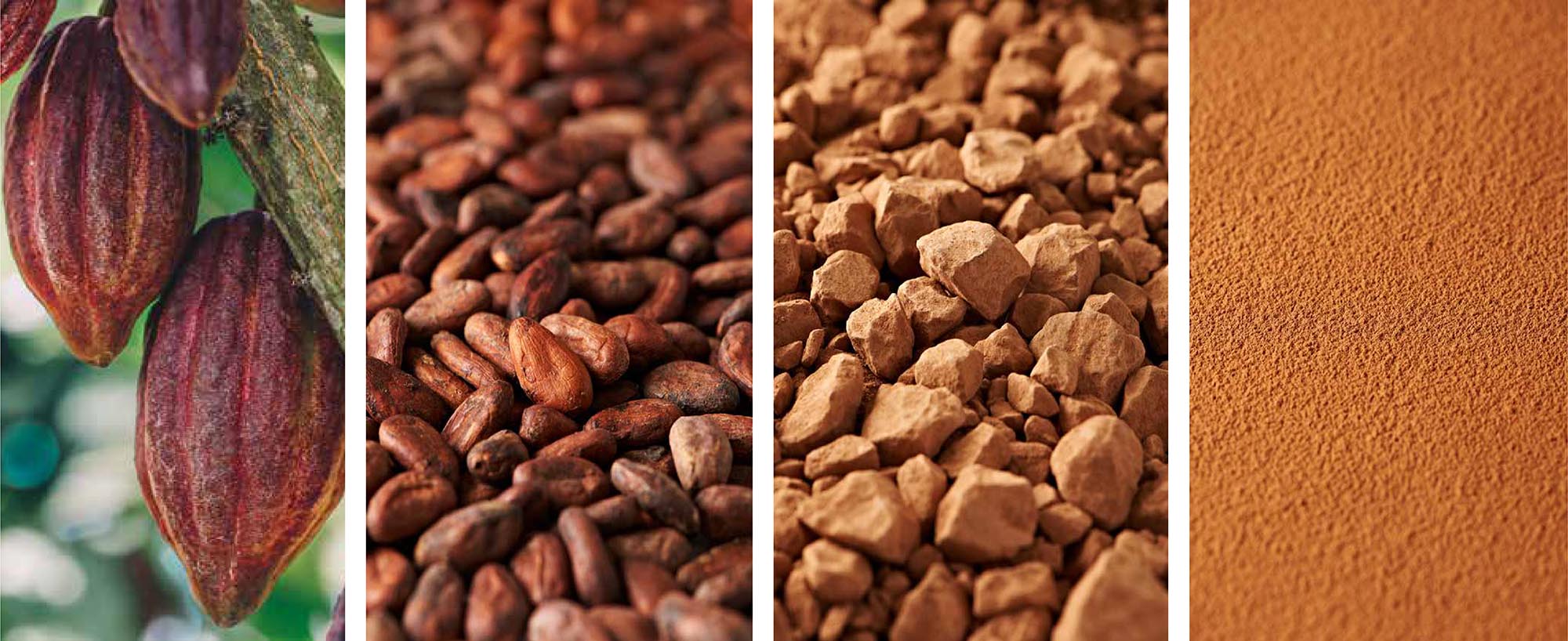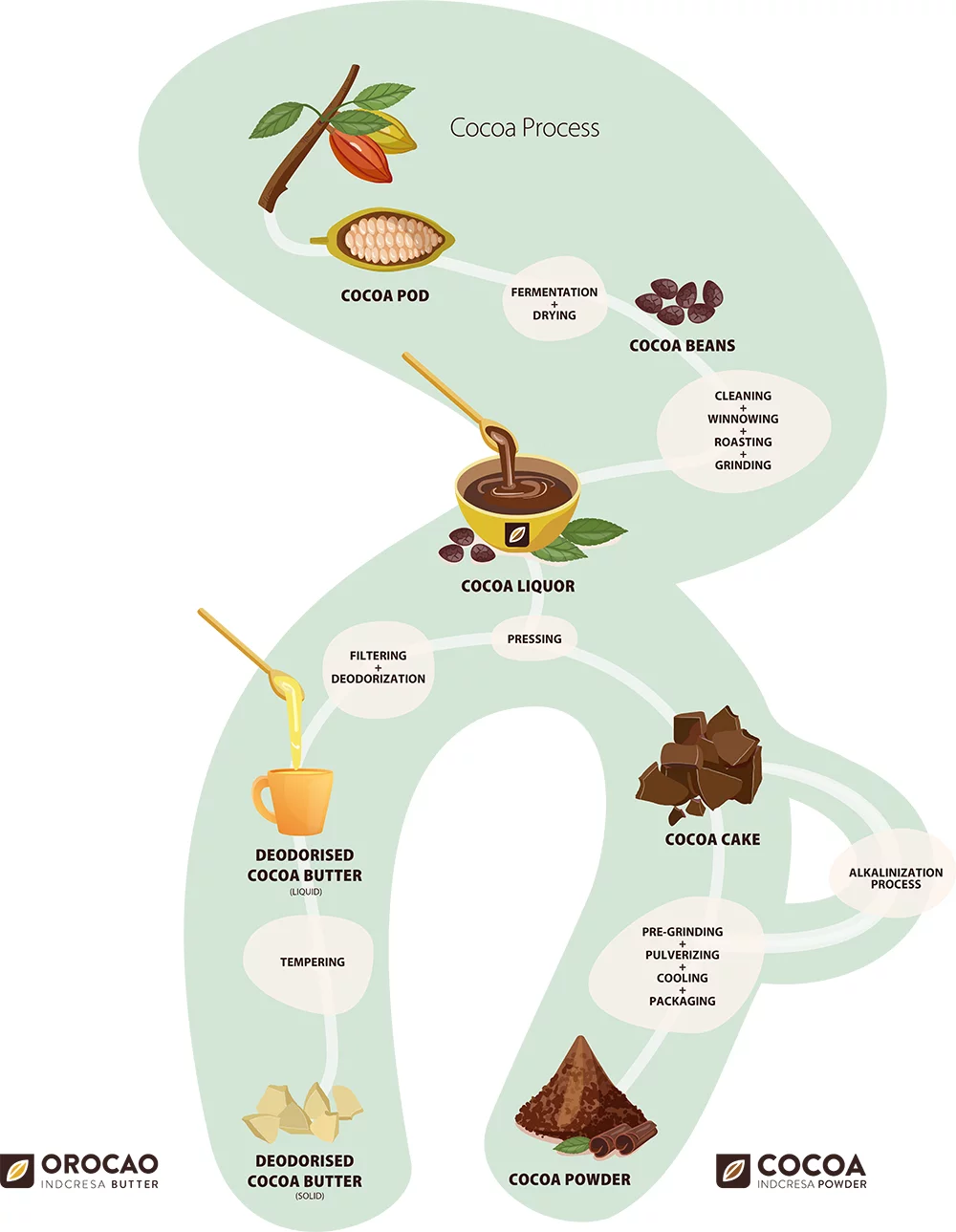
Our cocoa comes from the best producing countries in the World
Based in Barcelona, INDCRESA is the leading and largest manufacturer and exporter of high-quality cocoa powder in Spain. We select the best ingredients from the main producing countries, with maximum guarantees across the whole value chain from supply to the production of our Cocoa Powder.

The Cocoa Process - Step By Step
We work with the best cocoa-producing countries
The cocoa tree, scientifically called Theobroma Cacao, grows in tropical areas of Africa, Latin America, Indonesia and Malaysia. Its fruit is a pod, which is melon-shaped and has about 40 seeds inside. Each year there is one main and one second harvest. It is an exciting product, but it needs very specific climate conditions to grow, and it can only find these in certain parts of the planet. In addition, it requires other trees – banana and coconut trees, also called “mothers of cocoa” – because they provide the shade it needs and protect it from the wind and sun.
It is a tree that requires 4-5 years to reach maximum productivity and provides two harvests per year: the main one between October and March and the second one between April and September.
The fruit is also very interesting, as it grows on the branches and trunks of these trees, first as a flower, then becoming a pod. Only a few of the flowers become pods.
We work with the best cocoa-producing countries
Once the fruit is collected, the seeds are extracted, fermented and dried to obtain the cocoa beans.
Once producers understand that the harvest is ready to be collected, they do this by hand. This is because the process cannot be mechanised, as the cocoa pods do not all ripen at the same time. The harvester uses a knife to collect the pods, deciding which ones are ripe on a case-by-case basis.
The pods are then taken back to the farm and opened so they can ferment. Ideally, they will ferment on the same day.
The grains should not be damaged because this would pose a risk of insect infection.
Only good grains can go to the next stage: Fermentation.
The number of days needed for fermentation will vary depending on the variety of cocoa. There are three general types: Forastero, Criollo and Trinitario. Forastero is the most common variety and the most robust. It grows mainly in West Africa and is the one that needs the most days to ferment. Then we have the Criollo type, a more subtle and fruity cocoa that is mainly used to make chocolate. Finally, Trinitario is a hybrid between the two.
After this explanation, we will take a look at fermentation. At this stage, the pulp is critical for yeasts and bacteria. This process is initially applied to banana leaves. It is intended to obtain the precursors of the aroma. To know if it has properly fermented or not, we should look at the bean’s colour. It can range from violet to dark brown.
Once fermented, it is dried. Traditionally, it is dried in the sun, but in certain rainier places, artificial drying is used to obtain smoked aromas. The goal of this phase is to reduce humidity below 8%.
Once the beans are dry, they are packed and sent off to be processed.
Cocoa Liquor is the main ingredient in chocolate
In the industrial process, cleaning, husking, roasting, and grinding operations are carried out to obtain the cocoa liquor – the main ingredient in chocolate.
The actual production process begins with these 3 steps: Cleaning, breaking and shelling to obtain clean, cracked and shelled grains.
Once we have prepared the grains in this manner – we call them nibs -, we move on to the roasting process. This is one of the most important processes.
The roasting process is intended to reduce water content and further develop taste. It is in this phase that the final taste is obtained, because the precursors of the aroma formed during fermentation have just been developed. It is roasted between 95ºC and 145ºC depending on the machinery and the product to be obtained.
Low moisture content and high temperatures are needed to grind the nib, because this allows the cocoa butter to be released and this is how the cocoa liquor or liquor is obtained. It is a liquid liquor similar to drinking chocolate, but more bitter.
At this point, the product can be used in various ways. This cocoa liquor can be used directly for the chocolate industry or pressed to obtain two products: Cocoa butter and cocoa cake.
Cocoa Cake is the raw material we use to manufacture our different types of cocoa powder.
Subsequently, the cocoa liquor is pressed to obtain two products: Cocoa Butter and Cocoa Cake.
Cocoa Cake is the raw material we use to manufacture our different types of Cocoa Powder.
Here at Indcresa, we use cocoa cake as a raw material. It comes directly from the source country. It is the result of the extraction of the butter: the solid part that remains after pressing the liquor. The cake received at INDCRESA is classified according to quality and food safety criteria.
This cake is used both to manufacture our Indcresa Natural Cocoa Powder and to obtain different colours through an alkalisation process, thereby producing a wide range of cocoa powders.
INDCRESA is the first company in Europe to produce a whole range of Cocoa Powder from raw materials manufactured at the source.
As mentioned above, we can manufacture both Cocoa Indcresa Powder Natural and Alkalised Power. To manufacture the alkalised variety, we apply an alkalisation process.
This consists of balancing different variables, such as temperature, pressure and the process itself. We make sure that the cake has been sterilised and this is where we can modify the pH, colour and flavour to obtain reddish, black or dark brown cocoa powder. Once we have this intermediate product, we store it and then use it in the design of the recipes, grinding this mixture to obtain the Cocoa Powder.
When dosing the ground mixture, we add the amounts of cake and intermediate product specified by the recipe. There are as many recipes as there are products to be manufactured. This allows us to offer a wide range of Indcresa Cocoa Powder. We have developed an innovative technology that allows us to manufacture cocoa powder that is tailored to the customer’s needs. We have a fully computerised factory that ensures our recipes are consistent.
Specifically, the important thing in the grinding process is to reduce the particle size to obtain the desired appearance of the Cocoa Powder. Last but not least, we need to cool the cocoa powder so that the cocoa butter stabilises properly.
This last process is one of the most important because it allows the texture of Cocoa Powder to be maintained and clumping to be avoided.
This process occurs in the cooler. Here, a specific control system is used for each batch that is manufactured. Our team has the know-how to perform and monitor this process.
Once cooled and stabilised, we sift the cocoa powder to ensure the food safety of the final product, eliminating undesired elements. Lastly, we package the Cocoa Powder.
Multi-sheet paper bags (25 kg net weight)
Big Bags (400 to 1,000 kg net weight)
Tank (up to 21,000 kg net weight)
INDCRESA has specialised in cocoa products for more than 100 years, specifically in the manufacture of Cocoa Powder. Our products range from natural cocoa powder to various types of brown, reddish and black alkalised powders.
As well as our standard types, we can tailor parameters like fat content, fineness and pH to customer needs. We are customer-focused.
To maintain our quality standards, we manufacture our Cocoa Powder from a selection of sources and raw material mixtures made by our expert quality team.
This constant effort to improve and ensure quality has allowed us to become certified and join the ranks of the world’s leading cocoa brands.
OPERATING IN
ANNUAL CAPACITY OF

You choose how to
apply our Cocoa
